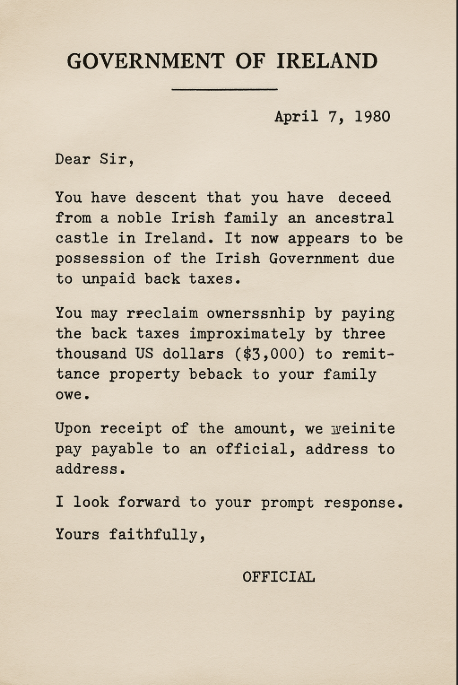Growing up, I often hear the story about how we( my family) once got a letter from the Government of Ireland offering to give us our castle back if we paid the back taxes. This was the 80’s and this was a physical letter and was used to bolster the idea that our family came from royalty.
I had forgotten about his story until a few weeks ago. This being 2025 and having worked with computers and the internet for the last 24 years I thought… this sounds like an old school version of Prince from The middle east email scams. so I asked our friend CHAT GPT.

Yes, there was a scam like that—and it’s one of the more legendary postal scams of the 1980s. While it may not have been as widespread as some of the better-known frauds (like Nigerian prince letters), the “Irish castle inheritance” or “back taxes on a family castle” scam did exist and is often cited as a classic example of romance-meets-financial-fantasy fraud.
🏰 How the Scam Worked
The scammer would send a physical letter—usually designed to look official or even governmental—to unsuspecting people in the U.S., Canada, or Australia. The letter claimed something like:
“You are a descendant of a noble Irish family that once held a title and a castle in Ireland. Due to unpaid back taxes, the property is being held by the government, but you can reclaim it by settling the outstanding balance.”
From there:
- The letter might include genealogical-sounding details to make it seem personal.
- A fee would be requested to either:
- Pay the supposed back taxes.
- Cover legal or research fees to “claim” your inheritance.
- Some scammers offered a “castle tour” or “legal conference in Dublin”, for which victims were asked to pay travel or registration costs.
💸 The Financial Angle
Victims would wire money or send checks for amounts ranging from a few hundred to several thousand dollars. There was, of course, no castle, no inheritance, and no government official involved—just a con artist exploiting nostalgia, family pride, and wishful thinking.
📰 Media & Pop Culture Mentions
This type of scam was occasionally reported in newspapers and consumer protection reports during the 1980s and 1990s. It was usually lumped in with:
- “Lost heir” or “noble title” scams
- “European inheritance” scams
- Predecessors to today’s advance fee frauds
🎯 Why It Worked
- Many people of Irish descent emigrated to North America in the 1800s.
- Family lore or vague records made the claim seem plausible.
- The romantic idea of a forgotten inheritance or a castle was too good to ignore for some.
🛡️ Lessons From It
It’s a great historical example of a scam that used emotional manipulation, heritage identity, and fake authority to get money—principles that still power many modern scams today (especially online).

